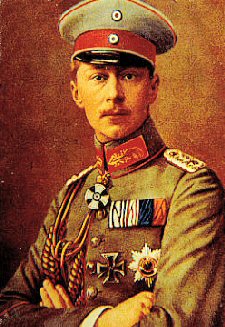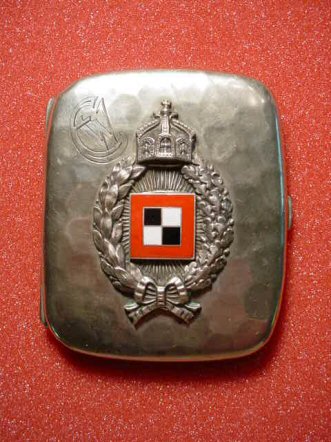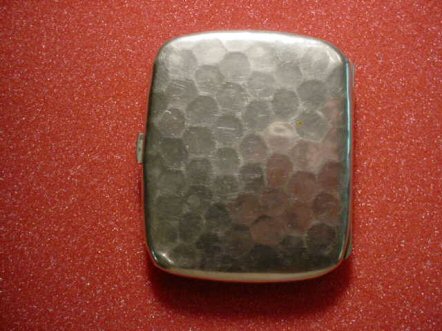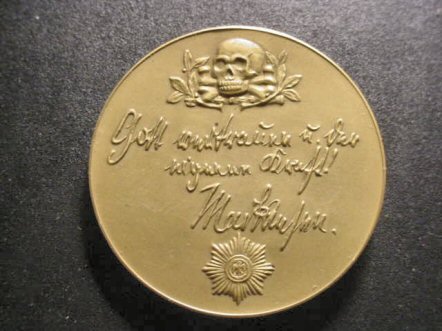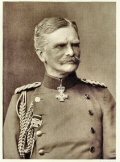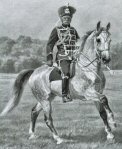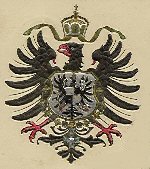|
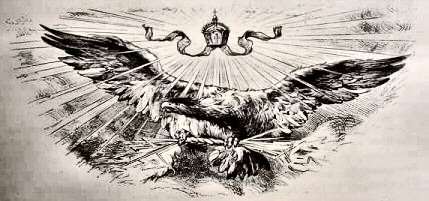

Medals
Page 3
Please be sure to visit our Kaiser Wilhelm II
collection.
|
|
|
The Star of the Order of the Black Eagle (Item KMEDAL 3-3)
|
| DESCRIPTION: This is a very fine specimen of the Prussian Order founded by King Frederick I of Prussia on January 17, 1701, as an award for outstanding civic or military achievements. After 1847, a recipient of this award automatically received hereditary nobility. Before that date only nobles were eligible. This example is unmarked although the style is definitely Godet. The condition is excellent with no chips to the enamel. It's of very heavy silver construction with the fine Godet-style retaining pin. The letters that spell "Suum Cuique" ("To each his own") are clear and concise. This is one of Imperial Germany's most beautiful and prestigious medals.
PRICE: SOLD
|
|
|
|
Genuine Miniature Blue Max (Pour le Mérite) (Item KMEDAL 3-5)
|
| DESCRIPTION: Here in all its minute, but glorious presence, is a beautiful example of the miniature of the Prussian Order Pour le Mérite (Blue Max). It appears to be struck in genuine gold with perfect blue enameling. Measuring a little less than an inch from arm to arm of the cross it is in pristine condition. The miniatures that we have seen are usually rather crude, even when authentic. This example is as fine as one of the large versions by Wagner or Godet. The detailing is superb and the fine enamel is bright and unchipped. Miniatures were struck for wear on civilian dress when the holder of the Pour le Mérite was not in uniform. It sometimes was incorporated into his medal grouping bar along with his other awards and sometimes worn separately in a ribbon-type affair that had a round device on its back that would fit into a buttonhole opening on the suit coat. The miniatures never reach the value of the full-sized Max, but actually may be more scarce, at least in this quality. This is a little gem with important historical value.
PRICE: SOLD
|
|

|
|
|
|
Pour le Mérite (Blue Max) with Crown (Item KMEDAL 3-6)
|
| DESCRIPTION: Here is one of the finer of the Pour le Mérite medals we have ever seen. Again, like so many found today it was probably made in the 1920’s or 1930’s as a replacement or wearing piece. This is definitely the preferred type sought after by collectors. Some of these were purchased by the Blue Max holder to be worn with the duty uniform in place of a valuable and delicate gold badge. Others made by various fine jewelers were undoubtedly purchased to replace lost or damaged pieces. Note that the characteristic of the issue World War I badges is the distinctive square formed by the tail feathers of the four eagles. The symmetry of this design is one way to judge the workmanship and authenticity of the badge. The eagles legs are narrow, delicate pieces extending to small foot pads on the arms of the cross; detail that can be seen on this magnificent example. The highest quality badges that were made by Rothe of Vienna and Godet of Berlin are found with very detailed, graceful eagles with cutout tail feathers. We strongly believe that this one is a fine Rothe piece because of the obvious quality that we have mentioned is all present here and the medal is enameled in a lighter shade of blue and this was characteristic of all Rothe pieces. The issued WWI Max’s were also of this color. This is the very rare version with the crown addenda that was established by Frederick Wilhelm III, who sought to expand the Orden Pour le Mérite to three grades one of which was to include the crown attachment. It was originally to be awarded to Pour le Mérite holders in possession of the order for 50 years or more. In 1889, a crown was adorned with diamonds as a special award to Field Marshal von Moltke on his fiftieth Pour le Mérite anniversary. Rothe of Vienna manufactured a slightly different form of crown with more shapely lines and many of the 50-year veterans, who were entitled, bought them, as they definitely had a better look than the originally issued examples. So, ladies and gentlemen, we have what adds up to a very legitimate Max here that can be easily considered fine and ultra-rare. It does have a couple of surface chips on the left arm of the cross and under the “F” plus another on the right of the crown. The magnification in my pictures will probably make them look worse than they look under normal visage, but they are surface chips and it is usual to find them on the face of these orders. The obvious reason is that when an example that was actually worn regularly is found this is usual, why? Because the Max was often worn dangling from the neck along with other suspension medals such as Hohenzollern order or Knight’s Cross, for example, and between bumping against the other ones and the proximity of buttons, etc. These orders often took a beating, but they were so finely constructed and tough that seldom did the slight damage go any further than the very top surface. The Max worn by Field Marshal Erwin Rommel was by Rothe and was quite chipped according to a historian, who had an interview with Manfred Rommel, his son. So here we offer possibly the best Pour le Mérite that we have ever seen. This is the ultimate for a 1920-1930’s Max.
PRICE:$7,950.00
|
|
|
|
Pour le Mérite (Blue Max) with Oak Leaf (Item KMEDAL 3-7)
|
| DESCRIPTION: This is a very fine example of the coveted German Order Pour le Mérite. This would be a late purchase rather than a WWI issue. It is a high-quality badge, possibly by Wagner of Berlin, but unmarked. It is of the light-blue-enamel color similar to the one made by Rothe of Vienna, but has the closed tail feathers and rather crude feet on the eagles. The mandatory square formed by the tail feathers is there, but not open as the Rothe examples feature. This is with the oak-leaf cluster of the style given to high-ranking field commanders for extremely significant military victories or major contributions to the war effort. The oak leaf was established as a separate and higher degree of the Pour le Mérite to be awarded for extraordinary achievements. The award of the oak leaves in the First World War was very closely controlled as was the special criteria for the award. The oak leaves were established on 18 January 1813, by King Frederick Wilhelm III. Note that the ribbon worn with the leaves is without center stripe. We would attribute this order to Wagner because of the closed tail feathers and the particular style of the oak leaf designing. Overall, the cross is minutely smaller in general than a Rothe example. In any case we feel that this “Blue Max” is one of the jeweler-made pieces that essentially were produced and sold to original Pour le Mérite holders in the 1920’s and 1930’s to be worn with the duty uniform in place of the valuable and delicate badge that possibly was in actual gold. These pieces were undoubtedly also purchased after the war to replace lost or damaged pieces. This is the slightly heavier and cruder example. The eagle’s head and neck are larger; however, this piece is quite well made and very beautiful. The tail feathers do form the distinctive square that is mandatory on original; and even on late pieces. This is a fine, wonderfully crafted Max regardless of the time period that it was created for even Göring wore a jeweler piece, while the original issue reposed in a drawer at Carinhalle.
PRICE: SOLD
|
|
|
|
Prussian Air Observer’s Badge
(Item KMEDAL 3-8)
|
| DESCRIPTION: Here is a great example of the WWI Prussian Observer’s Badge ”Beobachterabzeichen” für Fliegertruppe der Armee. the badge is in great shape except the retaining catch for the pin has been resoldered on. It is unmarked, but guaranteed 100-percent original. The enamel is unchipped, the detailing of the oak leaves and palm leaves is fine. The detail of the Hohenzollern crown is clear and concise. this is a very nice item and is reasonably priced. This is the Juncker style, but unmarked, so it probably was another company infringing a bit on Juncker. The crown is slightly larger than the Juncker model, but is detailed just as finely. It has “the barrel” pin assembly and is constructed in the two-piece method, but completely undetectable. It is in ‘800’ silver, but is not marked as such.
PRICE: $765.00
|
|
|
|
Imperial Badge Cigarette Case
(Item KMEDAL 3-9)
|
| DESCRIPTION: This is one beautiful relic of the Imperial Prussian Flying Service It is a great first-class silver case with a ”Beobachterabzeichen” für Fliegertruppe der Armee (the Observer’s Badge of the Flying Troops of the Army). The badge was affixed to the front of the case by a jeweler. The badge looks like it is from the manufacturer Carl Puellath. It is in really fine detail. The flag-like design in the center reminds one of the design used by the Imperial German Army as a flag of the commander’s staff. The crown at the top of the badge is the Royal Crown of the House of Hohenzolern, the ruling family of Prussia. The hammered-silver design is great! In the top left there is a set of initials (“CW”) and this is no doubt the initials of the airman that this magnificent piece was presented to. Inside the case is a presentation dedication beautifully engraved translated: “My wish: a sunny spring day for your entire life! E.L. 27.7.22”
PRICE: SOLD
|
|
|
|
General Feldmarschall v. Mackensen Medallion (Item KMEDALS 3-10; WWI 7-1)
|
| DESCRIPTION: This is a beautiful small medallion measuring 1 ½ inches in diameter in mint condition in the presentation case. It bears the fantastically fine portrait image of the great Field Marshal in his resplendent Hussar uniform and his family crest is shown in a shield. His medals Pour le Mérite, House Order of Hohenzollern are crisp and detailed. The saying that was echoed all over Germany comes from the call of v. Hindendurg, when he spoke of the bravery of Mackensen at Tannenburg, “Unser Marschall Vorwarts,” “Our Marshal Forward!” On the back is the leering skull of the Totenkopf Hussaren, the Death’s Head Hussars under which is a saying: "Gott vertrauen und der eigenen Kraft," "Trust in God and your own strength." Under the writing is the Prussian Guard star. His service to the Fatherland was one of the most illustrious and notable of all Prussian officers since Frederick the Great. In World War I he defeated the Russians in the battle of the Masurian Lakes (1914-15), conducted successful operations in Galicia, Serbia, and Romania, and in 1917 occupied Romania. Held by the French until December of 1919, he retired (1920) from military service and became a leader of the Stahlhelm, a monarchist veterans' organization. He later supported Adolf Hitler. He began his military service in 1869 as a volunteer with the 2nd Life Hussars regiment. During the Franco-Prussian War he was promoted to second lieutenant and recommended for the Iron Cross, Second Class. After an interlude at Halle University, Mackensen formally entered the German Army in 1873, with his old regiment. In 1891 he joined the General Staff in Berlin, where he was heavily influenced by the new chief, Alfred von Schlieffen. When Schlieffen retired in 1906, Mackensen was regarded by some as a possible successor, although the job went to Helmuth von Moltke. At the beginning of World War I Mackensen commanded XVII Army Corps as part of the Eighth Army first under General Prittwitz and then General Hindenburg and saw action in the battles of Gumbinnen and Tannenberg. Late in 1914 Mackensen took command of the new Ninth Army and was awarded the Pour le Mérite for actions around Lodz and Warsaw. Until October of 1915, Mackensen saw action in Galicia, and assisted in the capture of Przemysl and Lemberg. In October of 1915, he led a renewed Austro-German campaign against Serbia and finally crushed effective military resistance there. He followed this up in 1916 with a successful campaign against Romania (along with General Falkenhayn). For this he was promoted to Field Marshal, and he sat out the rest of the war as military governor. In 1920, Mackensen retired from the army but became very active in pro-military conservative organizations, particularly Stahlhelm and the Schlieffen Society. In the 1930's he was a visible supporter of Adolf Hitler, but his role was purely symbolic and he remained a committed monarchist; however, he was seen in full Hussar uniform very often with Hitler at the Reichsparteitag and hundreds of other NS functions. He appeared in a very moving ceremony at the funeral of Kaiser Wilhelm in Doorn, Holland in 1941. His life covered a century. He lived during four Prussian regimes. He was a pure product of Prussian soldiery whose fidelity was sworn to his emperor and later, his Führer. For him, Hitler was the man who reconciled the German people and its army. His opinion of Germany’s losses in both WWI and WWII was summoned up in his words: “Im Felde unbesiegt!,” “Undefeated in the field of battle!” Mackensen was the supreme patriot and always remained the epitome of the Prussian warrior spirit. In 1945, the proud old man beat off Russian and Polish looters that came calling in his village. He did this with sword in hand. He was 96 years old, but secure in the knowledge that he was in the Teutonic vernacular true Enormen or “giant” and the looters were Belanglosen (inconsequentials). The marshal died on November 8, 1945; his life having spanned the Kaiserreich, the Weimer Republic, and the Third Reich. To the day of his death he was a brave Hussar of the Deutsches Vaterland! The medal is a token memorial of this brave and noble man.
PRICE: SOLD
|
Contact Us
Please refer to item designator in parentheses in all correspondence.
Please E-mail for any additional information you may need.
If you prefer, contact 'Germania' at PO Box 68, Lakemont, GA 30552
or call at 706.782.1668.
Please! do not call during the wee hours of the morning. The best time for calling us is between 9 and 11 am and between 9 and 11 pm eastern time.
| |





